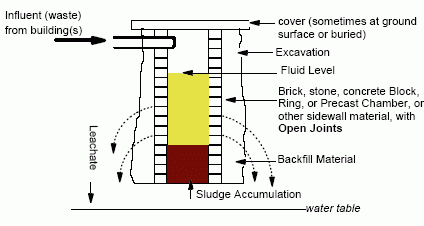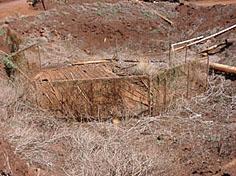Cesspools in Hawaii
Cesspools are more widely used in Hawaii than in any other state in the country. EPA Region 9 is responsible for implementing the regulations in Hawaii and works with the Hawaii State Department of Health (DOH) Exitto ensure effective implementation.
- Does this rule apply to me?
- You have a large capacity cesspool…now what?
- Compliance and Enforcement
- Frequently Asked Questions
- Regulatory Terms Defined
- Contact Information
Does This Rule Apply to Me?
Does your property use a cesspool for wastewater disposal?
If you do not use a cesspool for wastewater disposal, this rule does not apply to you. |
||
|---|---|---|
YES |
My Property is ResidentialOn your residential property, do two or more |
My Property is CommercialDo you own or operate a commercial property that |
If you answered 'YES' to any question above...
It appears that you have a large capacity cesspool... Now What?
You have a large capacity cesspool…now what?
Step 1
Submit an Inventory Form
All owners and operators of large capacity cesspools must notify EPA of their existence. Large capacity cesspool owners and operators must submit inventory information by using this online form or, if you prefer to mail it to EPA, use Form 7520-16: Inventory of Injection Wells and mail it to the R9 LCC Coordinator at the address below. If you need assistance with the form, please do not hesitate to contact us.
Step 2
Find an Alternative Wastewater System
Cesspool owners in Hawaii should consult with a wastewater engineer to learn what options are available to them. You may also contact the Hawaii Department of Health's (DOH) Wastewater Branch Exit to determine what regulations or codes apply to your situation. Plans for any new or replacement wastewater systems must be prepared by a professional, licensed engineer and submitted to the DOH Wastewater Branch for review and approval prior to construction. New wastewater systems must be installed by a licensed contractor and inspected by the design engineer during construction. The design engineer must submit the final Individual Wastewater System report to the DOH and receive written approval prior to operation. For information, contact the Wastewater Branch at (808) 586-4294. If you plan to connect to an existing sewer system, please contact EPA
Step 3
Submit a Compliance Plan
All owners and operators of large capacity cesspools are requested to submit a compliance plan to the R9 LCC Coordinator at the address below, which includes your name, address, Tax Map Key, a brief description of the alternative wastewater system and your schedule.
Step 4
Upon completion, notify EPA of upgrades and changes to your wastewater system
Upon completion, notify EPA of upgrades and changes to your wastewater system. Submit a copy of the Hawaii Department of Health’s ‘Cesspool Closure and Backfilling Report’ and/or ‘Approval to Operate’ to the R9 LCC Coordinator at the address below. Upon receipt of this documentation, EPA will update records and send you a letter acknowledging the upgrades to your wastewater system and informing you of your compliance with EPA’s UIC regulations.
Compliance and Enforcement
EPA's enforcement activities are designed to investigate and bring cases against individuals or facilities found in violation of the Safe Drinking Water Act's UIC regulations. Those found in violation may face enforcement action and fines. EPA is authorized to issue administrative orders requiring compliance and assessing an administrative civil penalty of no more than $16,000 for each day of each violation, up to a maximum penalty of $187,500, against any person who violates the Safe Drinking Water Act.
EPA Region 9 has entered into Consent Agreements with a number of entities in Hawaii, including public agencies, businesses and residential facilities, to address violations of the large capacity cesspool requirements. These enforcement actions required closure of about 1,100 large capacity cesspools statewide.
Other Frequently Asked Questions
- How do cesspools work?
- What is a large capacity cesspool?
- How is EPA identifying LCCs across the state?
- What does it mean to have the capacity to serve 20 or more persons per day?
- What if my cesspool disposes of more than just sanitary waste?
- My cesspool meets state rules, does the ban and closure requirement apply to me?
How do cesspools work?
Cesspools are “drywells” or underground holes that receive sanitary wastewater from building bathrooms and usually from the kitchens, clothes washers and/or dishwashers. A cesspool has an open bottom and/or perforated sides and the wastewater leaves the home and goes through a pipe into the underground chamber. While cesspools are designed to capture sanitary waste, they do not treat waste. The wastewater flows into the chamber; the wastes seep into the ground, but sometimes the solids remain inside the underground chamber.
What is a large-capacity cesspool?
 A very large gang cesspool, it is approximately 40 feet across and simply covered by wood planks.A large capacity cesspool is one that discharges sanitary waste with human waste and serves: (1) a multiple dwelling; OR (2) a non-residential location with the capacity to serve 20 or more persons per day. Single-family homes connected to their own individual cesspool are not subject to the federal UIC regulations. The number of persons served by a residential cesspool and the quantity of flow received by a cesspool are not specific considerations in the federal definition of a large capacity cesspool. However, if the flow to the cesspool is greater than 1000 gallons per day (gpd), it is also subject to the State of Hawaii’s Underground Injection Control (UIC) rules regardless of the number of persons served per day, which are implemented by the Safe Drinking Water Branch, UIC program.
A very large gang cesspool, it is approximately 40 feet across and simply covered by wood planks.A large capacity cesspool is one that discharges sanitary waste with human waste and serves: (1) a multiple dwelling; OR (2) a non-residential location with the capacity to serve 20 or more persons per day. Single-family homes connected to their own individual cesspool are not subject to the federal UIC regulations. The number of persons served by a residential cesspool and the quantity of flow received by a cesspool are not specific considerations in the federal definition of a large capacity cesspool. However, if the flow to the cesspool is greater than 1000 gallons per day (gpd), it is also subject to the State of Hawaii’s Underground Injection Control (UIC) rules regardless of the number of persons served per day, which are implemented by the Safe Drinking Water Branch, UIC program.
How is EPA identifying large capacity cesspools across the state?
EPA works closely with the Hawaii Department of Health, using its inventory of cesspools across the state as a reference source. The DOH, Counties and other entities refer suspected and known large capacity cesspools owners to EPA for follow-up. EPA also enforces this rule through public referrals, complaints and property transfers. Through random inspections of unsewered areas, EPA can also identify large capacity cesspools. Enforcement actions have been taken addressing over 900 large capacity cesspools state-wide.
For Hawaii, any cesspool that receives waste from 20 or more persons in any single 24-hour period is considered a large capacity cesspool, such as a church where 20 persons attend on any one day a week; or a business with 10-15 employees, plus 5-10 visitors on a given day. Enforcement actions have been taken addressing over 900 large capacity cesspools state-wide.
Regulatory Terms Defined
The following definitions are provided to assist you with understanding the regulatory requirements and are taken from the federal UIC regulations and Hawaii Administrative Rules Exit, Title 11, Chapters 23 and 62.
Cesspool: a well that receives untreated sanitary waste containing human excreta, and may have an open bottom and/or perforated sides.
Individual Wastewater System: a facility designed to receive and dispose of no more than 1000 gallons per day of domestic wastewater.
Sanitary waste (domestic waste): liquid or solid wastes originating from human activities, such as wastes collected from toilets, showers, wash basins, sinks used for cleaning domestic areas, food preparation, clothes or dish washing operations.
Seepage pit: an excavation in the ground which receives the discharge from treatment units and permits the effluent to seep through its bottom or sides to gain access to the underground formation.
Septic system: a system used to place sanitary waste below the surface and is typically comprised of a septic tank and subsurface fluid distribution system or disposal system, such as a leach field, absorption trenches or seepage pit. For additional information on septic systems, see EPA’s Septic Systems web page.
Contact information
Kate Rao (rao.kate@epa.gov)
(415) 972-3533
Mailing Address
Region 9 Large-Capacity Cesspool Coordinator
EPA Region 9 WTR-3-2
75 Hawthorne Street
San Francisco, CA 94105
Toll-free at (866) EPA-WEST (866) 372-9378
Disclaimer
- The statements on this page are intended solely as technical assistance. This information is not intended, nor can it be relied upon, to create any rights enforceable by any party in litigation with the United States.
- This page updates the information provided in Ban on Large Capacity Cesspools to Protect Public Health in Hawaii, (EPA 909-F-04-05, May 2004 Update/HI)
